Throughout this section, progress and programming are described in the context of India’s four overarching national health policy periods, shown below in Figure 15. These policy periods are described in detail within the
Figure 15: India’s national-Level health policy periods

Health infrastructure
India’s health system is described further in the national-level NMR/MMR Exemplars research, with the overall structure of the health care system shown below in Figure 16. Here, the health systems of Madhya Pradesh, Odisha, Rajasthan, and Uttar Pradesh are explored in depth, highlighting intermediate and distal health system factors that contributed to the status of each as an Exemplar state within the higher mortality state cluster.
Compared to the lower mortality state cluster—which had a relatively mature health system at baseline—the higher mortality state cluster faced more issues related to service availability and access due to initial shortages of health infrastructure and human resources for health. In this landscape, health systems within the higher mortality state cluster focused on establishing a strong foundation for progress, expanding health infrastructure and human resources, prioritizing community outreach to generate demand, and promoting access to care in communities.
Figure 16: India’s health care system in the public and private sector

Morampudi S, Balasubramanian G, Gowda A, Zomorodi B, Patil AS. The challenges and recommendations for gestational diabetes mellitus care in India: a review. Front Endocrinol (Lausanne). 2017;8:56. https://doi.org/10.3389/fendo.2017.00056
As in other states across India, community health centers (CHCs), primary health centers (PHCs), and health sub-centers (HSCs) serve as a backbone of the public health system, with district, referral, specialty, and medical college hospitals serving as facilities capable of offering more advanced care. The density of these facilities varied considerably across higher mortality Exemplar states, as shown below in Figure 17. In Odisha and Rajasthan, the densities of CHCs, PHCs, and HSCs were generally higher than average for the higher mortality state cluster—especially for CHCs. In comparison, Madhya Pradesh has facility densities on par with the higher mortality state cluster average and Uttar Pradesh has facility densities substantially lower than the higher mortality state cluster average. Consequently, in 2018–2019, Uttar Pradesh on average had one CHC per 244,000 residents, whereas Odisha and Rajasthan had roughly one CHC per 100,000 residents. In general, Exemplar higher mortality states saw more substantial increases in CHC density, whereas PHC and HSC densities maintained relatively constant over time. Compared to the lower mortality state cluster, the role of the private sector in the higher mortality state cluster is more limited, with a larger proportion of births occurring in public facilities.
Figure 17: Trends in the density of community health centers, primary health centers, and health sub-centers in India, higher mortality cluster, Madhya Pradesh, Odisha, Rajasthan, and Uttar Pradesh

India Ministry of Health and Family Welfare (MoHFW). Rural Health Statistics 2018-2019. New Delhi: MoHFW; 2019. Accessed September 10, 2024. https://ruralindiaonline.org/en/library/resource/rural-health-statistics-2018-19/
Madhya Pradesh
Although the density of rural infrastructure such as PHCs and HSCs has remained relatively constant over the past three decades in Madhya Pradesh, the density of CHCs has increased. Whereas in 1985–1990 there was one CHC per 285,000 people, by 2019–2020 the rate had increased to one CHC per 192,000 people. In addition to bolstering the network of CHCs, Madhya Pradesh has focused on targeting improvements to facilities—often rural HSCs—in areas known to have high rates of home birth that were geographically distant from other facilities that would typically operate as places for delivery care. One government health official spoke to this process by saying:
“Initially, we mapped some 1,400 delivery points. Then with the time to care approach we mapped some sub-centers also, which were far off and, in their vicinity, there was no delivery point within [a] 10 to 15 km radius. So, some 360 sub-centers were also identified as delivery points. We placed one additional auxiliary nurse midwife there and SBA [skilled birth attendant] training as given to her—how to use misoprostol and these things. So out of the total deliveries, some 2%–5% started happening in sub-centers.”
Many of the state’s efforts to better equip lower-level facilities were necessitated by the increased demand for services fostered by the ASHA and Janani Suraksha Yojana (JSY) programs, which were central to the National Rural Health Mission. Madhya Pradesh was also the first state to introduce a district-level call center that dispatched a fleet of vehicles, subsequently followed by an integrated call center at the state level that helped coordinate free referral transportation as of 2013 with UNICEF support.
Odisha
The state of Odisha has an above average density of PHCs and HSCs, with many experts noting that access to rural health infrastructure was instrumental in spurring maternal and newborn health progress. In particular, the density of CHCs increased rapidly in Odisha, which by 2019–2020 had one CHC per 98,000 people compared to one CHC per 294,000 people in 1985–1990. The state focused on upgrading many CHCs to first referral units (FRUs) to increase access to delivery points capable of offering more complex obstetric care. The FRUs were complemented by the establishment of facilities specializing in newborn care, such as NICUs in medical colleges, special newborn care units (SNCUs) in district hospitals, newborn care corners, and newborn stabilization units.
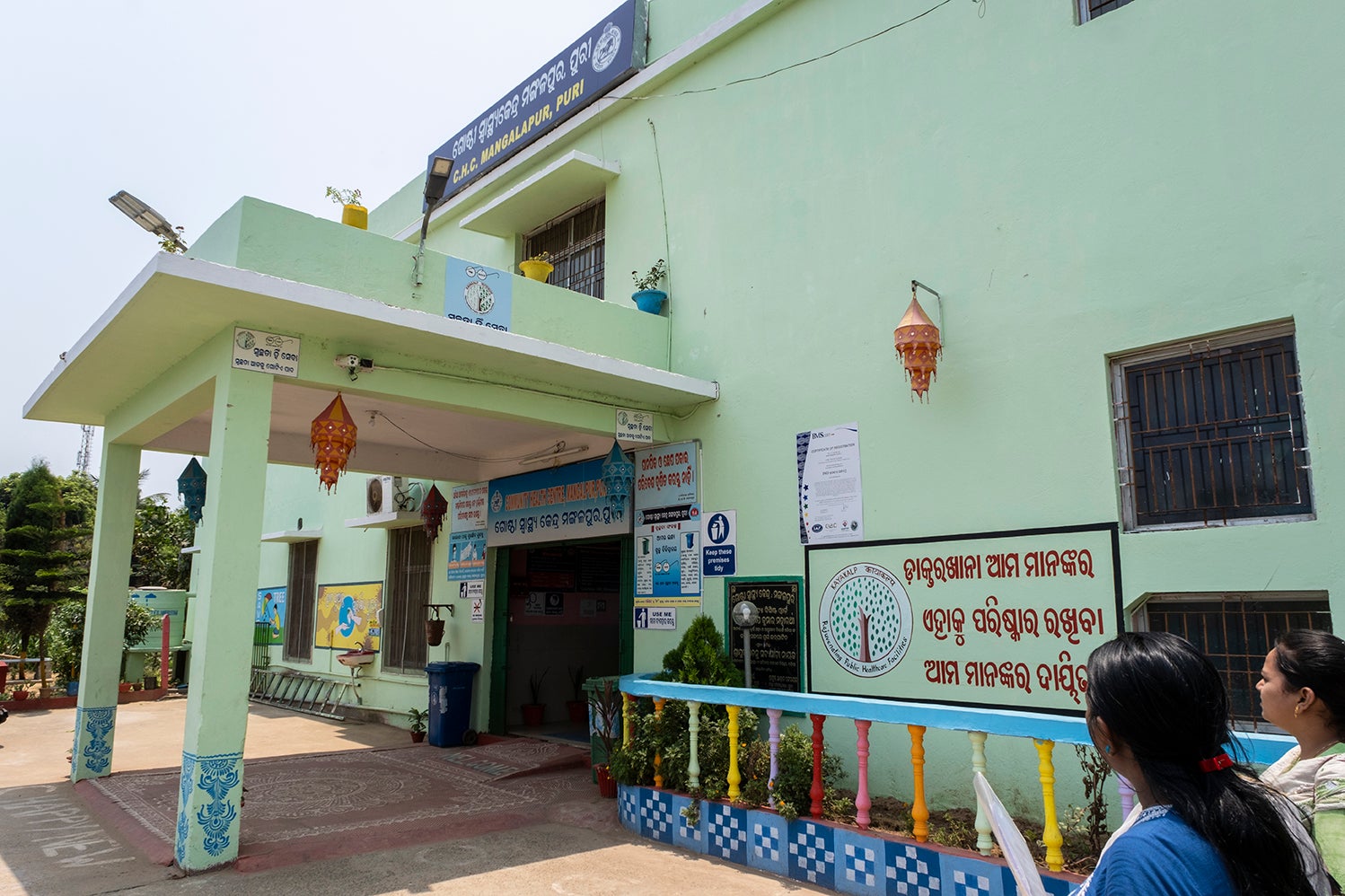
Odisha also introduced maternity waiting homes known as Maa Gruha, which welcomed mothers and their attendants two weeks before their estimated delivery date. Here, antenatal care, food, and housing would be provided. Uniquely, management of maternity waiting homes was outsourced to local people who received operational stipends depending on the number of pregnant women in the home, thus incentivizing operators to recruit more women.
Rajasthan
The densities of PHCs and HSCs in Rajasthan have remained above the average for the higher mortality state cluster for decades—reflecting the role these facilities play in delivery care in the state. Compared to other states, the FRUs in Rajasthan are noted for their staffing issues, commodity stockouts, and lower quality of care. As a part of the national maternal and newborn health toolkit designed by the Ministry of Health and Family Welfare, PHCs were capacitated to become delivery centers. Rajasthan shifted deliveries from overloaded CHCs, FRUs, and district hospitals to underutilized PHCs and HSCs by improving labor rooms at these lower-level facilities. These improvements have included the reorganization of labor rooms, the implementation of checklist protocols, and the improvement of supply availability. The 2015 Kushal Mangal Program has helped high-risk pregnancies be identified even at low-level facilities such as HSCs.
In more recent years, the state has particularly focused on newborn care, as it was noticed that NMR was not declining in line with MMR as institutional delivery was improving. The establishment of SNCUs in five high-priority districts marked a key step in remedying the discrepancy, with these units later scaled up to every district.
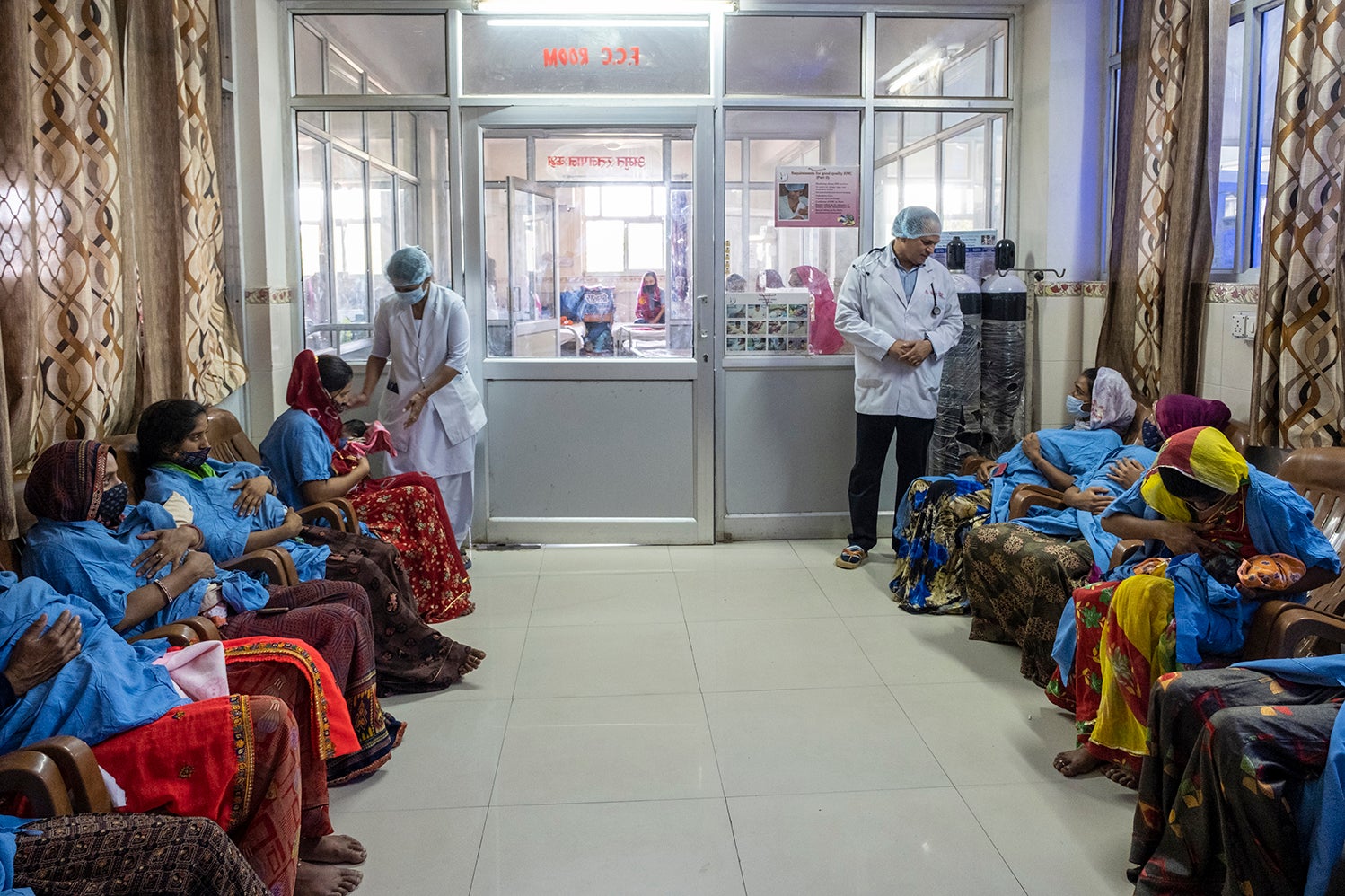
Uttar Pradesh
Similar to other higher mortality cluster Exemplar states, the density of CHCs in Uttar Pradesh saw substantial increases over recent decades while the density of more rural infrastructure such as PHCs and HSCs plateaued and slightly declined. The relatively low density of facilities became a challenge for the state in the mid-2000s when programs such as the ASHAs and JSY began to spur major increases in demand for institutional delivery. As one government health expert explained:
“Lady doctors used to come to the meetings, and they used to ask CMO [chief medical office] also, “What to do? We don’t have gloves, we don’t have instruments, we don’t have table.” . . . Deliveries were multiplying. And ASHA was a really motivated force.”
Over time, management systems became more adept at using NRHM funds to handle the delivery volume. One example is infrastructure expansion to create FRUs, maternal and child health wings, and SNCUs, which increased the capacity of the state’s health system.
Human resources for health
Compared to the lower mortality state cluster, most states in the higher mortality cluster experienced a relative shortage of specialists, doctors, and medical officers. For this reason, higher mortality states tended to focus on strengthening the capacity of providers such as ASHAs, auxiliary nurse midwives, and nurses. Exemplar higher mortality states effectively implemented national task-shifting strategies and training initiatives while also employing innovative approaches to strengthen, organize, and motivate their existing workforce.
Madhya Pradesh
The capacity of health workers was strengthened in Madhya Pradesh through several skill labs and the introduction of a common training platform for frontline health workers involved in child health, nutrition, and maternal health. Auxiliary nurse midwives, ASHAs, and staff nurses were often the workers most targeted through skill labs, with more upstream approaches including training faculty at nursing and auxiliary nurse midwife training schools. The state also offered a fellowship to allow medical officers to access courses for specific skills, such as ultrasound, which would allow the officer to be eligible for a promotion. Though the state had a shortage of specialists, these efforts to strengthen the capacity of lower-level providers were noted by experts as key measures that strengthened the capacity of the state’s health workforce.
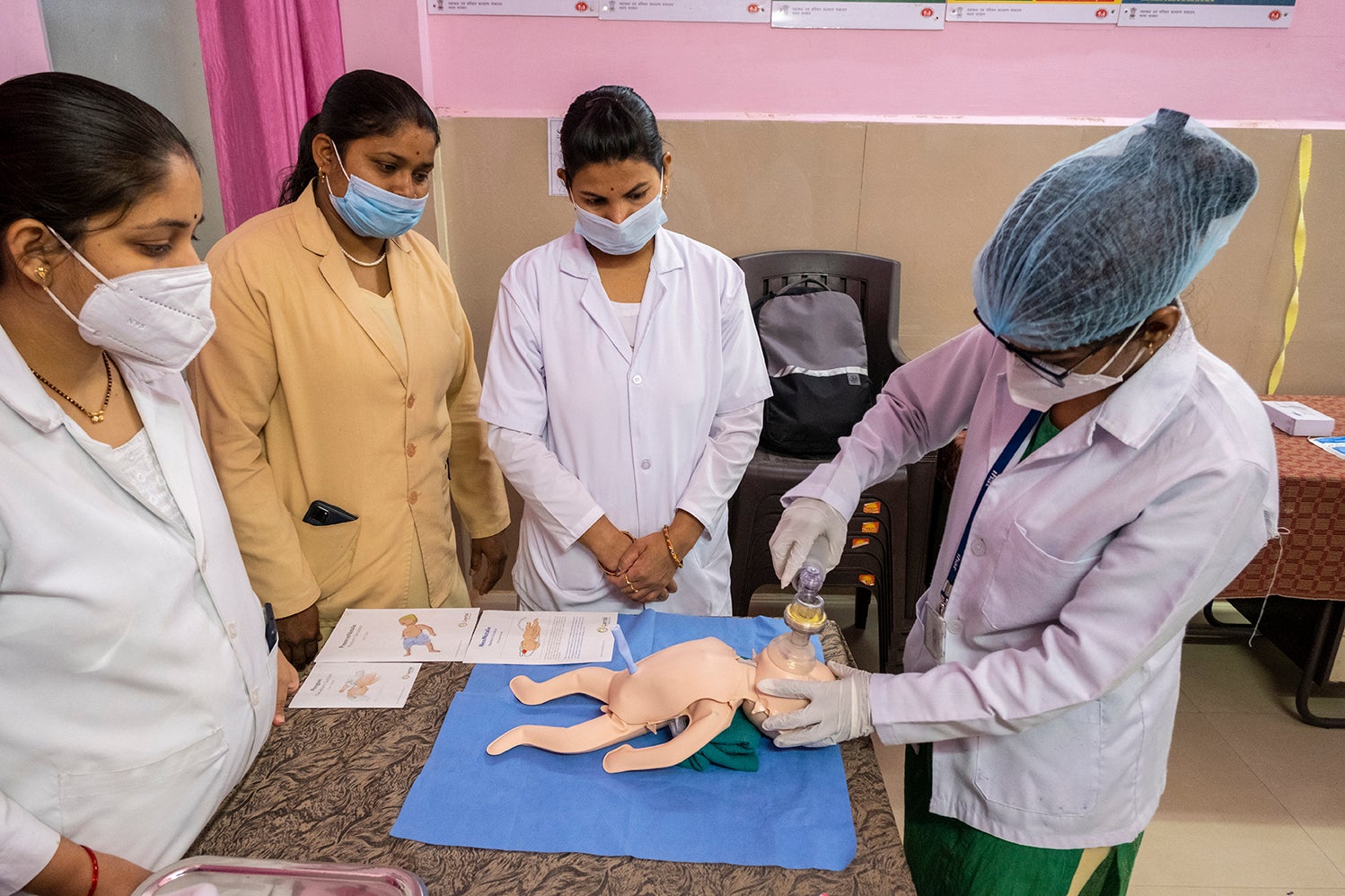
Odisha
Capacity strengthening among auxiliary nurse midwives, ASHAs, and nurses has also been key in Odisha. In addition, the state was the site of the Indian Council of Medical Research’s study into how ayurveda, yoga and naturopathy, Unani, Siddha, and homeopathy (AYUSH) doctors, who provide the six forms of non-allopathic medicine in India, could be trained to administer high-quality maternal care. This work found that 30 days of pretraining was able to satisfactorily prepare AYUSH providers for the standard 21-day SBA training. In addition to this training program, Odisha has also recently added the Navjaat Shishu Suraksha Karyakram (NSSK) training on newborn care for all health workers (a national program) and Social Awareness and Action to Neutralize Pneumonia Successfully training to improve pneumonia management among newborns. Many of these trainings have been held by the State Institute of Health and Family Welfare, which has been so effective in its trainings that it serves as a model for human resources for health training for other states. Its approach utilizes a hub-and-spoke model that matches state medical colleges to peripheral facilities, enabling knowledge and skill transfer in a localized fashion.
Rajasthan
Skill upgrades for nurses were also prioritized in Rajasthan, driven by the reality that this cadre of health workers was responsible for the majority of deliveries in the state. The relative shortage of specialists and medical officers made skill upgrades for auxiliary nurse midwives especially crucial. These efforts were later supplemented by efforts targeted at strengthening the capacity of auxiliary nurse midwives to improve neonatal health, such as the NSSK training and integrated management of newborn and childhood illnesses (IMNCI) training. The state would go on to improve preservice education for auxiliary nurse midwives by incorporating skill labs in schools with hands-on mannequin trainings. One academic expert spoke to the potency of empowering lower-level providers such as auxiliary nurse midwives in a system with a shortage of specialists, saying:
“So if that first point of contact [the nurse] is competent and confident, I think he or she can handle [the] majority of cases who are coming there. Leave alone the referrals and the distances and other complications which take place en route. And there have been numerous success stories in the past decade where this has happened, that the trained labor room staff has managed that delivery well. And averted probably and complication there. So I think that is another important point [on] working with limited staff, which I think the state has been able to do.”
Rajasthan also empowered its network of ASHAs, specifically seeking to address an issue of low motivation. Trainings, team-building exercises, and improved timeliness of payments were key responses that the state took to address this issue, with one government health expert particularly noting the importance of the electronic ASHASoft portal to address payment issues, noting:
“There are, there were 50,000 ASHAs, and the problem was, they were expected to do many awareness things, but they were not getting their payments on time. So our first IT intervention was to make ASHASoft, which won the National Award also, for the e-Governance initiative, in 2016. And which was replicated by many states.”
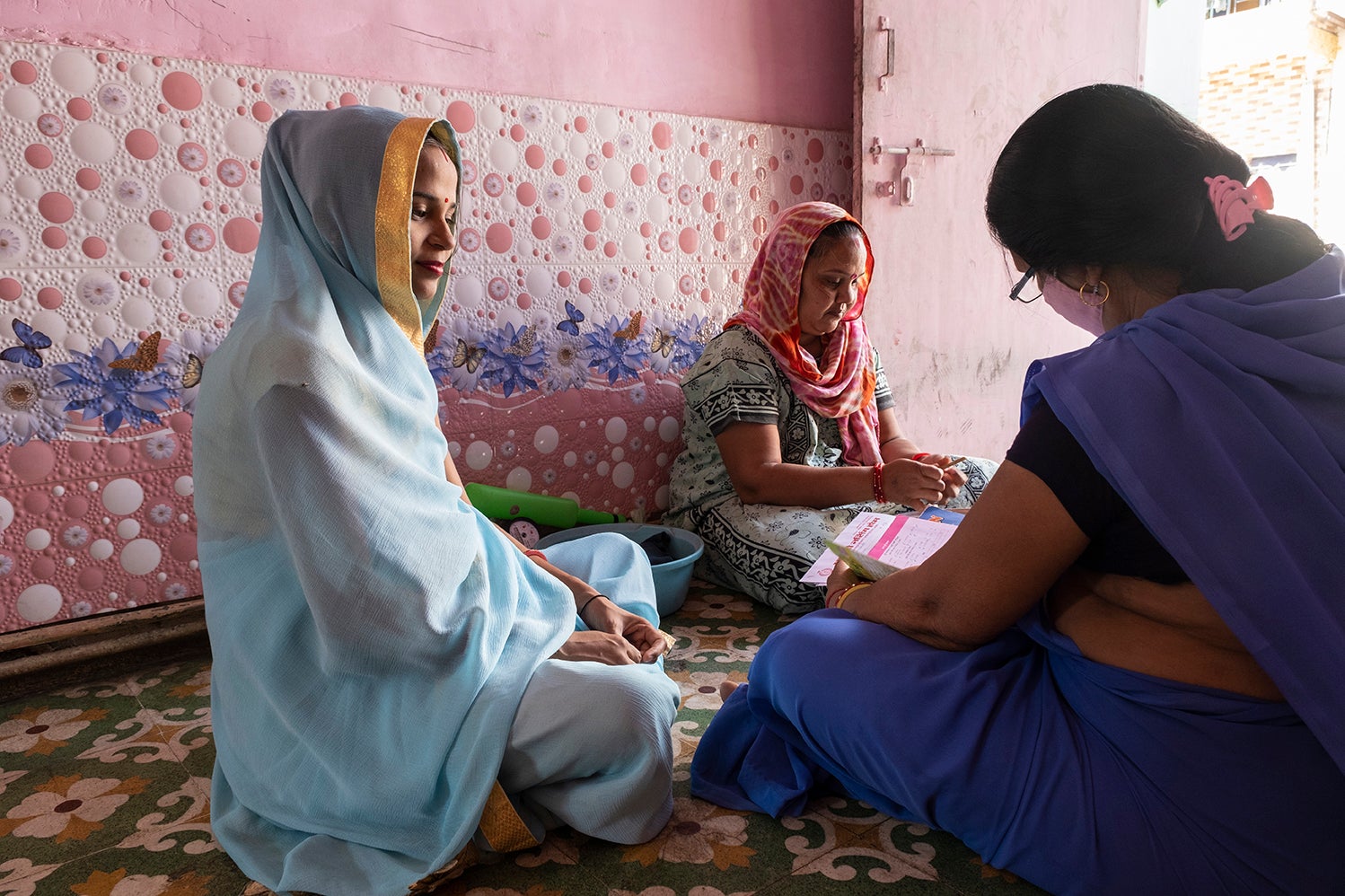
Uttar Pradesh
In addition to capacity strengthening programs for auxiliary nurse midwives such as the NSSK and IMNCI trainings, the state of Uttar Pradesh also undertook a novel nurse mentoring initiative. This program was started in 2014 in 100 blocks within the state’s most high-need districts. After training a cadre of nurse mentors, these experts provided staff nurses in health facilities with hands-on labor room training and supportive supervision. This approach was found to be effective and later was scaled up to all 75 districts in Uttar Pradesh. Mentorship also existed between regional resource training centers and their supported FRUs as well as state newborn resource centers and their supported SNCUs. Medical college faculty provided on-site mentoring to specialists, doctors, and nurses at the FRUs and SNCUs.
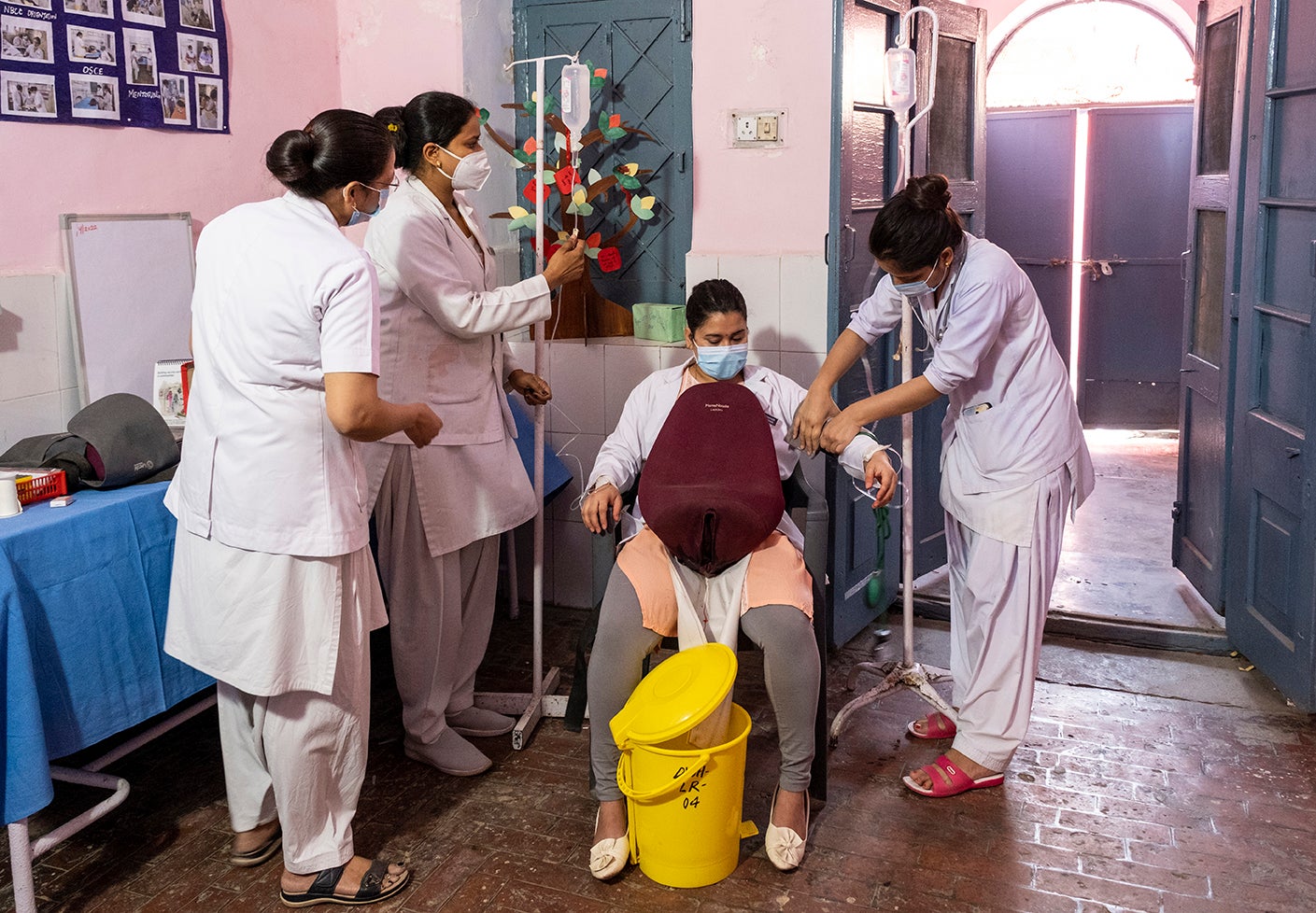
Community engagement and demand generation
The higher mortality cluster generally implemented national programs such as JSY and Janani Shushu Suraksha Karyakaram (JSSK) effectively, garnering increased demand for services via ASHA support and reduced financial barriers. State-specific initiatives complemented these national programs, with digital tools often underlying these structures to ensure organization and coordination across states with large, complex health systems.
Madhya Pradesh
A founding principle for public health in Madhya Pradesh is Jan Bhagidari, meaning “the responsibility of the people.” The state’s leaders interpret this to mean that all health issues require community education and buy-in to be successful. This ethos is evident in several of the state’s attempts to promote community engagement, including the Mahila Swasthya Divas, which have strengthened community-level ANC and assisted in identifying high-risk pregnancies. It is also apparent in the state’s approach to establishing, in areas without internet access, an ambulance system that relies on block-level local support networks. A system of community leaders that includes district- and block-level mobilizers and managers underlies outreach services throughout the state.
Widespread community engagement is evident in Madhya Pradesh because the state was found to have the highest level of access to the JSY conditional cash transfer for institutional delivery. The state went further in 2018, adding a state-specific cash transfer called the Mukhya Mantri Shramik Seva (Prasuti Sahayata) Yojana that incentivized ANC, institutional delivery, breastfeeding, and newborn vaccination. One government health official spoke to the population’s buy-in to these programs, saying:
“It’s an entitlement. That consciousness is there as a part of the Jan Bhagidari model amongst our people. So they know that once the institutional delivery is done, I should get that DBT [direct benefits transfer].”
Odisha
The state’s ASHAs were described by one government official as “very vibrant” and a main reason for the state’s progress in institutional delivery, high-risk pregnancy identification, immunization coverage, and mortality decline. Seeing the impact of ASHAs, Odisha upgraded from a recommendation of one ASHA per 1,000 people to one ASHA per 500 people—especially in higher-risk areas. This increase has contributed to the state’s successful implementation of national programs such as JSY and JSSK that have driven community uptake of services.
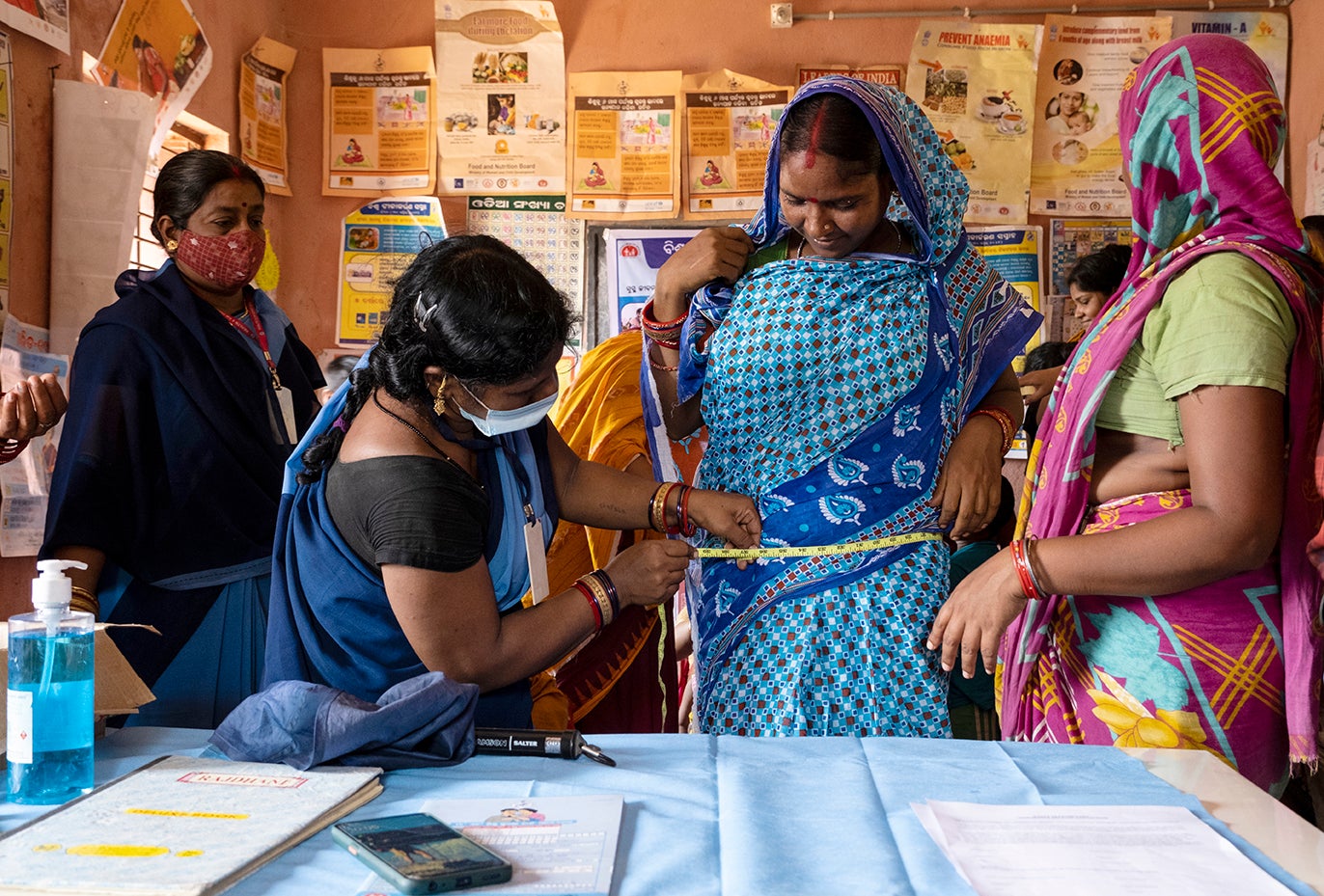
Beyond these national initiatives, a network of ASHAs, auxiliary nurse midwives, and other health workers also frequently visit hard-to-reach villages to conduct additional ANC visits and to identify high-risk pregnancies. As a part of the state’s 2017 Shishu Abond Matru Mrutyuhara Purna Nirakaran Abhiyan (SAMPurNA) Yojana program, families were given cash incentives to pay for travel costs to health facilities, including paying stretcher bearers who carried women on foot. The state also recently introduced a program called Vayu Seva, which brings specialists by ambulance to care for critical patients in remote areas.
Rajasthan
The ASHA program played a key role in increasing demand for services in Rajasthan. Using the electronic ASHASoft system, the state was able to monitor the performance of its ASHAs, proactively identify areas for improvement, and dismiss ASHAs that were not meeting expectations. In addition to effective implementation of JSY and JSSK, the state also introduced additional initiatives meant to promote the uptake of services. This included Prasav Sakhi, a policy that allowed all women to have a birth companion with them at institutional deliveries. A woman in labor could choose any woman who had already experienced childbirth to be her birth companion, with appropriate infection control materials to be provided to this companion so that she could be present for the delivery in support of the mother. These measures were meant to ensure that mothers received care they were satisfied with, with one government official noting that the state believes a “satisfied client is the best ambassador for us.”
Uttar Pradesh
Community trust in Uttar Pradesh was noted to have improved substantially, driven primarily by ASHAs and auxiliary nurse midwives which facilitated Village Health Sanitation and Nutrition Days (VHSNDs). The VHSNDs were successful in bringing ANC closer to women, which experts described as key in increasing ANC coverage. Removal of financial barriers through the JSY program contributed substantially to improved institutional delivery rates, which a representative from a local technical support organization described by saying:
“The single most important thing that has driven the fall in maternal mortality ratio, I feel, is the improvement in institutional delivery rates, which in turn, I think, there are two reasons I would say to that broadly—one is the implementation of JSY, and there has been a lot of accountability setting that has happened on the implementation of JSY from the early days.”
Uttar Pradesh also created Surakshit Matritva Saptah, or Safe Motherhood Weeks, which were later adapted by the government of India to become Pradhan Mantri Surakshit Matritva Abhiyan (PMSMA) or the Prime Minister’s Safe Motherhood Program. Under PMSMA, women were offered antenatal care on a fixed day every month, with private-sector doctors brought into government facilities to further support the program.
Process reviews and quality improvement
As in lower mortality Exemplar states, scrutinous reviews were also common in higher mortality Exemplar states, such as common review missions to provide support from the center. These reviews generally focused on identifying opportunities for improvement in ways that were honest, constructive, and less punitive. Data from these processes—increasingly coordinated through advanced health management information systems—were able to inform several evidence-based improvements in care. In more recent years, these improvements have often focused on newborn care in particular.
Madhya Pradesh
A large focus was placed on improving the quality of ANC. Identifying signs of anemia and hypertension have particularly been prioritized, with these risk factors being featured in trainings provided to auxiliary nurse midwives. Iron sucralose and double-fortified salt have also been prioritized in the state’s distribution system along with relevant screening equipment including ultrasound devices. Administering ultrasounds was specifically encouraged through trainings meant to empower providers to overcome cultural barriers surrounding the practice.
The state also made major strides in improving its health system’s procurement process. In 2014, the state set up the Madhya Pradesh Public Health Services Corporation Limited, a public state government company that acted as the central procurement agency for all essential drugs and health care equipment for health centers, hospitals, labs, and other facilities. Previously, each district was responsible for procurement, which resulted in uneven drug availability and an inefficient supply chain. The corporation reduced stockouts by streamlining the supply chain through more timely updates on inventory and usage.
Several of the state’s improvements, including those on ANC and supply chain, were identified as priorities through scrutinous review processes. One such process, the state’s time-bound grievance redressal system features strict hierarchical accountability, as issues progress from the Block Medical Officer to the Chief Medical Health Officer, up to the Joint Director for Health Services, and even the Health Commissioner. One government health expert noted that this system “sent signals down the line” that government services must always be accountable and responsive to citizens’ needs. The state also instituted monthly maternal death review meetings that took a problem-solving rather than a blame-oriented approach, leveraging data that featured name-wise tracking of all high-risk pregnancies and comprehensive information about each woman’s treatment path. One government health administrator spoke to this approach, noting:
“Reviews were very important and were a very regular feature. . . . We used to have regular state reviews, we used to have divisional reviews, and then the maternal death reviews that were very important, and it was not fault finding, it was more of learning from each other, identifying the faults, not exactly faults but identifying the problems, then trying to work at solutions.
Odisha
Administrative and government officials have proven responsive to survey data and have engaged in frank reflections on the state’s successes and failures. The state developed a strong data system that enabled each pregnant woman to be tracked through a portal called Ashish. The state also established call centers to make outgoing calls to people asking about the quality of health services they received. The state has established a system of rewards for providers and facilities that have the highest patient satisfaction scores, a departure from the previous approach that punished poor performers. Verbal autopsy and death reviews have also adopted a nonpunitive approach that brings together experts to review cases and plan for the future.
Some of the key interventions emerging from these reviews include the distribution of red cards to women identified as being at high risk during ANC. This card ensures that the ASHA and auxiliary nurse midwife are highly aware of the woman’s risk category during her pregnancy and that staff are aware at the delivery point during labor. Another intervention was training on underutilized medical equipment such as ultrasound machines and pneumatic anti-shock garments. Lack of knowledge was combatted with a series of recorded trainings that taught health workers how to use equipment that was widely available in health facilities across the state. A third intervention was ASHA-led home-based newborn care in the days after birth, which has proven essential for identifying and referring newborns with danger signs. ASHAs now visit over 98% of the state’s newborns, with one government health expert describing its impact by saying:
“I’ll be explicit in saying that the home-based neonatal care is a mainstay for picking out danger signs [and] referring them. And this HBNC strengthening is our, one of the major mottos, a major target to strengthen the HBNC.”
Rajasthan
The state has been a leader in the development of digital health services including payment portals, worker monitoring, and outcome surveillance. In particular, the state’s Pregnancy, Child Tracking & Health Services Management System was identified as an important data system, collating many data fields into the state’s health management information system in a way that allows for review of individual patients’ care progressions. This system is scaling up to hundreds of the state’s most busy facilities to track performance against key indicators and to track rates of key outcomes such as stillbirth, neonatal mortality, birth asphyxia, and infection at the facility level. This culture of data monitoring permeates the state’s approach to iterative improvement over time, with digital tools regularly contributing to health care decision-making. One government official spoke to the importance of data management as a component of a functional health care system by saying:
“When you compute any data, [the] doctor has done very well, auxiliary nurse midwife has done very well, consultant has done very well. But if [the] computer operator has not entered the data, how you will come to know we are doing better or we are not doing [better] at all? So you have to involve not only [the] ASHA and auxiliary nurse midwife, even, you have to involve computer operators.”
Guided by rigorous data systems, Rajasthan specifically targeted improvements to its lowest-performing areas. The Common Review Mission was introduced to identify widespread gaps and suggest solutions that had worked in other areas, with experts noting that these review visits were helpful for empowering and encouraging field-level officials. In 2017, Rajasthan also introduced the Chirayu program, which focused on newborn care in districts with the highest neonatal mortality. Under this program, each district was expected to prepare an action plan on how to prevent neonatal mortality, implementing stillbirth and neonatal death reviews. The program has focused on strengthening SNCUs, C-section capabilities at FRUs, birth tracking, and referral transport for newborns. One government health expert spoke to the impact of this program, noting:
“Chirayu program we have started. The 10 districts which are having almost highest infant mortality, we have intensified visits and [are] working on the gaps. We worked for two to three years; things have been changed in a good manner.”
Uttar Pradesh
A data-driven approach to monitoring was central to progress in Uttar Pradesh. Apps such as the ASHA app enabled each ASHA and high-risk pregnancy to be tracked, allowing managers to look into granular details. In 2015, several dashboards were established, and the state health system institutionalized regular dashboard reviews that enabled rapid identification of problematic outliers, leading to problem-solving that one government official described by saying:
“That [dashboard data review] had its own impact because then we could reach those CHCs which we probably would have left out. We could see, okay, in this particular district if we have 20 CHCs, eight were supposed to be FRUs, but no institutional delivery is happening in one. Now why? There was a doctor who was there, a gynecologist was there, there was a pediatrician who was in another CHC. They were not both put together. The moment you put them together it starts working.”
These reviews yielded insights such as the importance of HBNC, equipment availability at ANC, and opportunities to streamline referrals. The state developed a system in which ambulance drivers were briefed on where to take women with high-risk pregnancies, with drivers able to use an electronic system to look up her pregnancy risk status using her phone number. The state also changed referral policies so that the referral slips needed to be signed by doctors when possible, increasing the odds that the mother would receive an intravenous drip and consequently decreasing the incidence of complications during referral. Other digital tools such as WhatsApp groups for providers within referral network also strengthened the system and improved management of high-risk pregnancies.
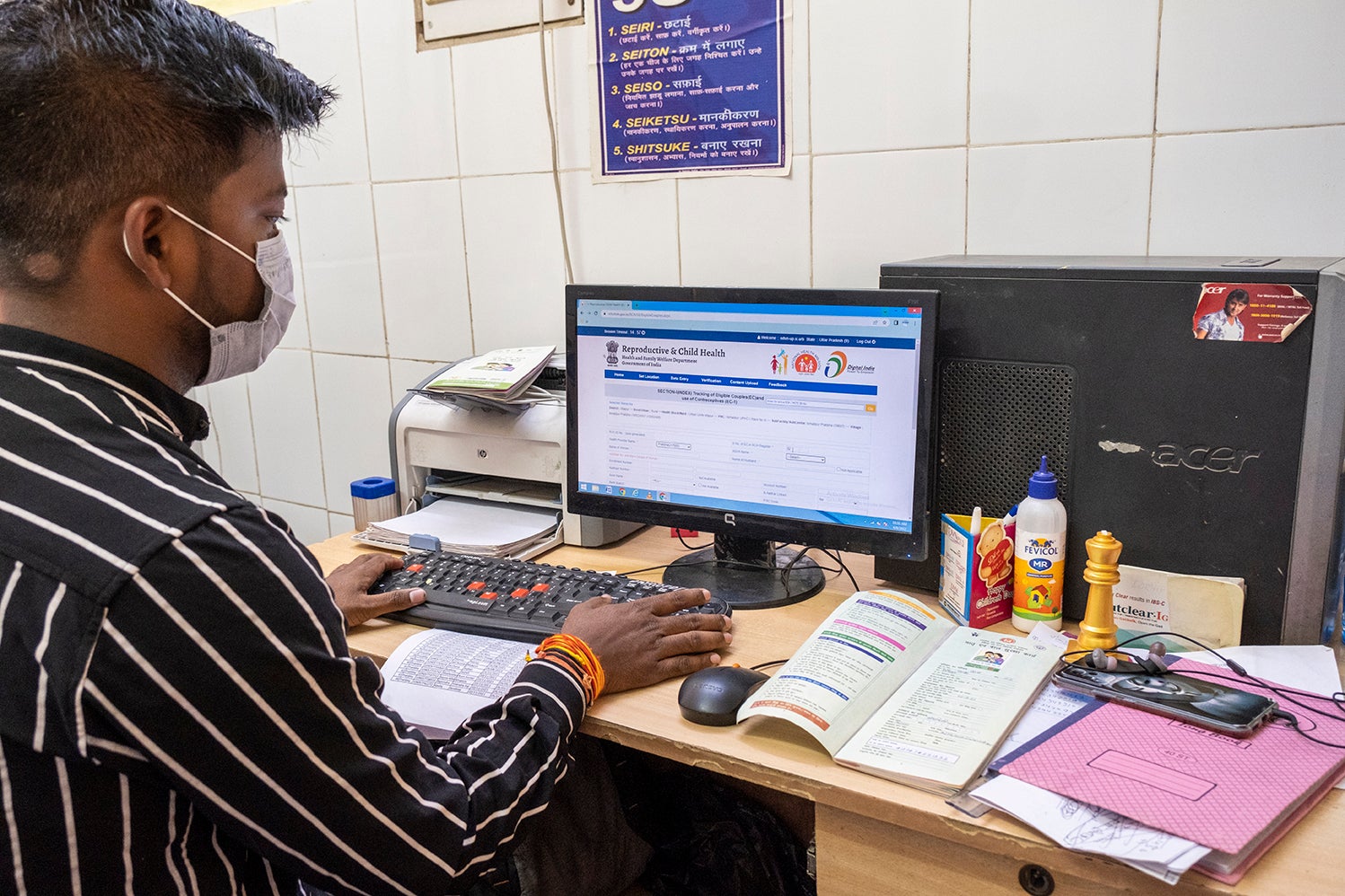
Strong governance and political will
Higher mortality Exemplar states were found to exhibit good governance, with consistent leadership that prioritized health—especially of mothers and newborns. A key theme that emerged across states was the tendency to be open to suggestions and to adapt based on existing evidence. Across states, rigid funding mechanisms in particular were identified as a barrier that underwent substantial streamlining over recent years, similar to the processes noted in lower mortality Exemplar states. This streamlining generally allowed states to target funds more appropriately to areas or priorities that most needed the funding, with fewer bureaucratic processes that might constrain this flexibility.
Madhya Pradesh
While implementing national programs and using national guidelines was core to Madhya Pradesh’s success, the state also developed and piloted several innovations that were adopted into national policy. These included identifying appropriate equipment for anemia assessment during ANC, integrated training on health counseling for frontline workers, and the approach to setting up SNCUs. One civil society member attributed these changes to the state administration’s “openness to ideas” and its culture of “learning from the field.” Trust in fieldworkers is exemplified through the state’s encouragement of frontline-level purchasing of routine equipment, ensuring that small-scale purchasing decisions could be flexible and localized. One government health official noted that although government employees are often fearful of using government funds for such purchases because of potential audits, Madhya Pradesh uniquely instilled confidence in their frontline workers to make these small-scale decisions.
The state also implemented a “global budget system” to increase access to larger-scale allocated funds. Experts described that previously, money was provided by the state to the district, then facility—which resulted in delays in money transfers. Program officers were given greater flexibility to re-allocate budgets based on need in the new system in which money was available at a common location and could be accessed through an electronic dashboard. This process was flexible and allowed for resources to be reprioritized more quickly, with one government official noting that the “judicious” approach made the best use of available funding to address maternal and child health needs.
Madhya Pradesh also had several departments that showed initiative in improving maternal and child health, beyond only the Ministry of Health and Family Welfare (MoHFW). The Ministry of Women and Child Development and the Ministry of Rural Development also contributed initiatives—such as protein supplementation among pregnant women—that directly supported the aims of the MoHFW. One government health official noted how unique this was, saying:
“We also have days—there are times when even rural development seeks out and says that we want to do exclusive campaigns for your mothers. Not the other way around. It usually—in other states I would feel that the health department will request the other two departments to do; the other way around also happens in our state.”
Odisha
Experts felt that the state showcased local ownership of its programs but was also open to innovations and good practices coming from across the globe, country, or state. Leadership in Odisha was also remarkably stable over recent decades, with directors, secretaries, and other leaders serving and sometimes extending their terms. The state’s secretary of health was also a medical doctor, indicating the state’s political commitment to technically sound approaches to health system challenges. The structure of the state’s governance facilitated systematic planning and ensured administrative and technical processes worked together rather than interfering with one another. When issues arose, such as new research showcasing high incidence of anemia, the state formed steering committees. These committees included secretaries of several relevant departments and oversaw district-level task forces as well as block-level task forces that engaged in microplanning. The structure of this approach facilitated need-based planning for key issues, allowing for localized solutions that were still plugged into the state’s broader problem-solving on the issue. This coordination was also rooted in a financial system that allowed for reallocation of budgeting during the year as priorities shifted, with state finances flexible across districts. One government official spoke to the strengths of this approach, saying:
“The flexible fund system is there. . . . So even for SAMPurNA [Shishu Abond Matru Mrutyuhara Purna Nirakaran Abhiyan] we have a state plan for that. In that plan also we have revised four times. We have added many activities, we have to add many activities. So it is always flexible. . . . Because of that flexibility it is possible to do the need-based planning. Even the district, also—they have taken up many kinds of activities from their district fund.”
Rajasthan
Experts noted that in delivering nationally developed health programs, Rajasthan took an “implementation science” approach wherein they learned and adapted over time. One academic expert spoke to this approach:
“What Rajasthan has demonstrated, we should emphasize that . . . is implementation science on the ground. What the state team has done, probably inputs to be consolidated, and mixed with various innovations and ideas, and then do it at scale, and sustain it, has been I think one of the learnings. . . . So I think one of the commendable efforts has been to sustain that, and institute mechanisms to try and sustain that, once the pilot goes off, or probably the development agency goes off. . . . So Rajasthan has always pitched for doing that.”
Examples of this iterative approach include breaking down ASHA incentives to especially incentivize early registration of pregnancies and more effective ANC, developing a comprehensive ANC training package, introducing multireagent urine dipsticks for maternal infections, and recently, the testing of group ANC. The experts credited this adaptive approach to Rajasthan’s “good governance” and “great leadership” that were “very supportive” of trying new approaches when the evidence indicated it might be necessary. It was also noted that sustained support often took the form of individuals championing initiatives and pushing them toward success over longer periods of time.
Uttar Pradesh
The experts reported that Uttar Pradesh’s government health actors showed ownership over and pride in their health programs, with strong support for health initiatives. Uttar Pradesh’s health system actors noted a shift away from the central government “pushing” programs onto the state and toward the state “pulling” in support of their own programs. Under the previous push model, demands were placed on frontline health workers who were “exhausted,” which often led to health workers focusing more on reporting than performing and implementing change. Under the new pull model, programs and reporting forms alike were integrated and rolled out by frontline workers who had more meaningful support. State officials also became very active in monitoring districts, checking the performance of PHCs and CHCs, and providing feedback to local officials. Senior leaders were known to frequently visit and spend the night in remote locations to truly understand the local issues and gaps that needed to be addressed.
Other management innovations were also instituted, especially those that provided financial flexibility. Whereas funds had been historically difficult to manage because of the way they were allocated, this system was revamped to ensure funds could be directed to where they were most needed. As one government official described it:
“We had to struggle very hard to put in systems. How could they utilize that money? How ASHAs could get money? And the result is that we had to change everything. . . . We had to invent things, and we had to invent processes we had to put in. That was very easy because the flexibility was there with governing body and local state bodies."
